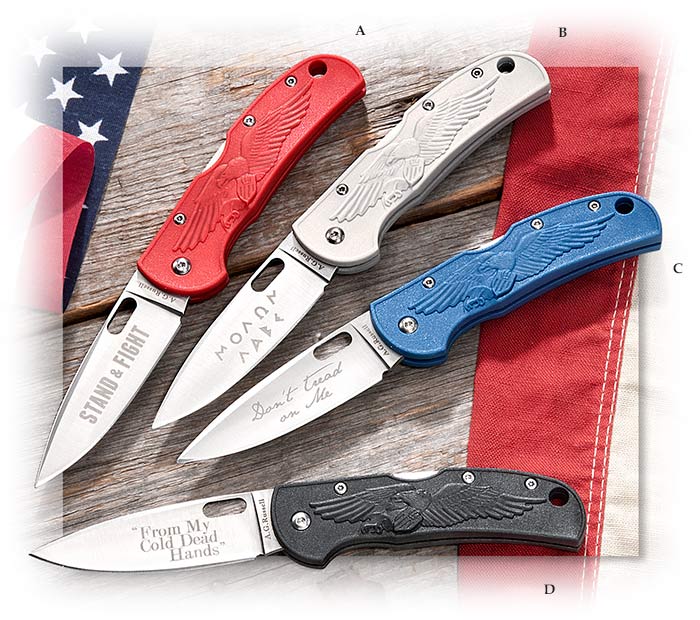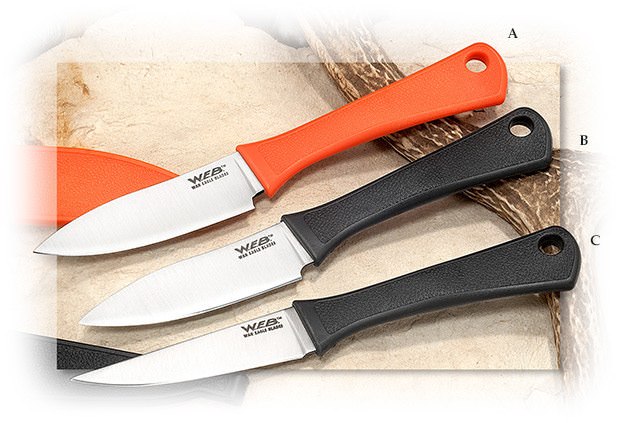Buying Your Child's First Knife
You want to know what knife to get your child for their first knife. For those who just want quick information, let me cut to the chase and give some quick recommendations. If you keep reading, I will go into detail below.
Updated April, 2018
Suggested Knives
Safest Knife
Pocket Skinner - $14.95

Simple, affordable, easy to hold, no moving parts, orange easy to find.
Safest Folding Blade
American Eagle Mid-locks - $24.95
Traditional Lockback Knife. Large enough that it will require two hand opening for children, forces a two hand close.
Slip Joint Pocket Knife
War Eagle Small Toothpick - $17.95 (in yellow)
Easy blade slip joint knife. Very traditional in origins. More explanation on slip joints at the bottom.
Multi-Tool
Leatherman CS Keyring Tool - $29.95
Small, easy to use, with a few different tools to help use the right tool for the right job.
Buying the First Knife
 Your child’s greatest hero in this world is you. They want to be just like you. They see you using your knife, and they want one too. I think it is incredibly important to pass on your love of knives to the next generation. It is a sort of rite of passage, a milestone on the road to growing up.
Your child’s greatest hero in this world is you. They want to be just like you. They see you using your knife, and they want one too. I think it is incredibly important to pass on your love of knives to the next generation. It is a sort of rite of passage, a milestone on the road to growing up.
I have many parents come into the store, and they have a few questions about how they should go about making this a great, but safe, memory. So let me answer a few questions.
How old should my child be before I give them their first knife?
Only you can truly answer this. Each child is different. Every child’s motor and decision-making skills are at different levels. I, myself, was given a knife far too early. At the age of 5, I cut myself pretty bad, severing some tendons. I wrapped my hand in a red handkerchief, and hid my wound from my mother. I still, to this day, do not have full use of my thumb. Later that month, my knife was taken away from me after I ruined mother’s dressing table. I learned to respect knives the hard way.
On the other side, don’t be overly protective. Eventually your child will feel smothered and will do something dangerous with a kitchen knife or other such thing. Your child just wants to be like you, and more than likely they want to be like you now.
Take some time and think about your child.
If you decide your child is too young to handle a knife, a good alternative might be to get a wooden knife kit. You can assemble the knife as a project together, and then it will work great as a training tool to explain the Do’s and Don’ts of knife handling. Say, “Show me you can be responsible and take care of this knife, and when you are ready I will get you a real knife.”
Below is a VERY general guideline and will depend completely on your child and your judgement. You, ultimately, take full responsibility for whether your child is competent and mature enough to handle sharp objects. I am writing this article to give you confidence not to wait too long, nor to give your child a knife too early. Did you know there is a pre-school in Denmark who teaches students knife skills?
 A good general age range for supervised knife use is somewhere between 5 and 7 years old. Buy a first time knife, explain how to properly use a knife, and only let them use the knife while you are instructing and watching carefully. This period may last a couple months, or several years before you are comfortable with their decision making skills and their dexterity. Some experts suggest introducing knives at even earlier ages. Take a look at this NPR article on Kids with Cooking Knives. Cooking is an excellent way to begin knife training. Start with a butter knife, and move your way up.
A good general age range for supervised knife use is somewhere between 5 and 7 years old. Buy a first time knife, explain how to properly use a knife, and only let them use the knife while you are instructing and watching carefully. This period may last a couple months, or several years before you are comfortable with their decision making skills and their dexterity. Some experts suggest introducing knives at even earlier ages. Take a look at this NPR article on Kids with Cooking Knives. Cooking is an excellent way to begin knife training. Start with a butter knife, and move your way up.
Then somewhere between 7 and 9 they might be ready to own their own knife. I really cannot emphasize enough that every child is different. Some may not be ready for unsupervised use until as late as 12, and sometimes even later than that. You will have to have to make the call on that. If you have not been instructing your child how to use a knife for a while, they may not be ready for one of their own.
One mistake I see made is some parents think, “Tim’s older brother was mature enough for a knife by 8 years old. Now that Tim is 8, he is also ready for a knife.” This is not always the case. Even siblings who grow up in the same household mature at different rates, and it is very important to think about your children individually when it comes to something potentially dangerous like knives.
Be sure to balance safety and a little freedom. It is my opinion that if you didn’t need band aids growing up, you did not have much of a childhood. Nothing will make a knife completely safe. Knives are sharp objects, and are designed to cut things. By the very nature of the thing, they are dangerous. The important thing is to teach proper use.
How much should I spend on the first knife?
There are a few things to keep in mind while buying a first time knife. The first is that you get what you pay for. Don’t buy a cheapo $5 gas station knife. It is going to break, and your child might be injured. On the other side of the coin, experts estimate that there is a 75% chance that your kid is going to lose their first knife. I made that statistic up, but you get the idea. Only your kid should be crying over the lost knife, if you are crying too you paid too much for it. Get a knife somewhere between the $10 and $40 range. Check out the War Eagle Blades brand, or some of the value knives from CRKT or Kershaw. Use the price filter on the side to filter out the more expensive knives.
What size knife should I get?
I do not actually get this question very often, but I think it is more important than many realize. Many people think, “Well, my kid has small hands. I’ll get a small knife.” Small knives often required a higher level of dexterity, and are more complicated to operate than some of the bigger knives. I suggest a medium sized knife. Get one that will fill their hand, and take two hands to open and close. It is not like your kid has limited pocket space, most kids don’t have a wallet or cell phone taking up precious pocket real estate yet. Get a bigger, easy to use knife. Your goal is ease of operation. If the blade is too difficult to open or close, it increases the risk of injury significantly.
What kind of knife should I buy for the first knife?
The majority of parents get a folding blade. However, young children have not yet developed full dexterity in their hands, and sometimes folders can be difficult to operate. A fixed blade will be the safest blade for a child, plain and simple. The child doesn’t have to worry about any of the mechanics of opening and closing the blade. Get something like a War Eagle Pocket Skinner.
Now of course a big part of this is that your kid wants to be like you, and if you carry a folding knife, that’s what they will want. I suggest getting a simple fixed blade for the years of knife supervision, and then get your child a folding knife when you think they are responsible enough to carry a knife on their person.
If you want to do full progression, you could get a wooden Nathan’s Knife, a War Eagle Pocket Skinner, and then a American Eagle Mid-lock.
All children are different, and how they will use a knife will dictate how best to teach them to use one. If you don’t want to get your child a fixed blade, or they want a pocket knife instead, then you need to decide how that knife should function. The simplest lock form is the lockback, but this lock type is sometimes difficult for children to operate as the lock can be stiff. Liner style and frame locks can be challenge to operate with a child’s motor skills. Certain slip joint knives can be too stiff for children to operate as well. I always tell parents it’s a good idea to let the child hold the knife in person before purchasing. This can be difficult to accomplish as many places do not allow actual knife handling. But, a family owned knife store may be more flexible. If you’re in the Rogers, AR area, you can come to our Retail Store and we’ll be glad to let you handle any of the knives.
Slip Joint knives?
%20.JPG)
Thank you all for reading my article. If you wish to stay up to date on the newest articles, they will be posted on the A.G. Russell Facebook Page.
Written by A.G. Russell III and Jake Broce





